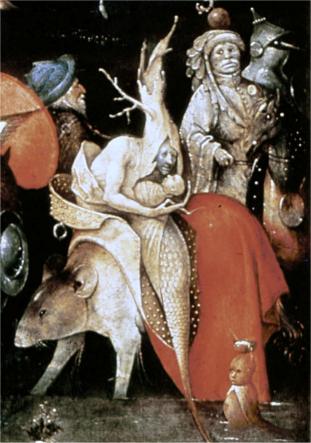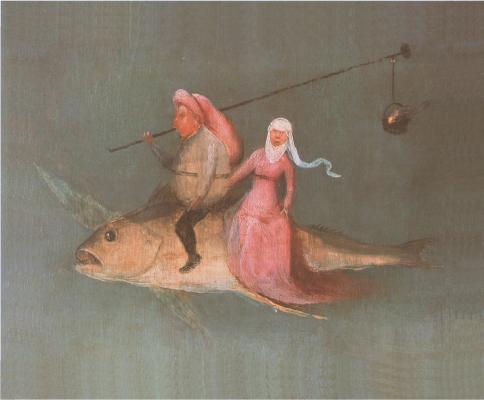








The complex interpretation of the sources for Bosch's imagery advanced by Dirk Bax in a series of books and articles issued from 1948 onwards. Bax convinced himself that Bosch drew on local folklore and sayings as well as the Bible. Bosch then is supposed to have translated such verbal descriptions into visual imagery, using various literary devices, punning, word-play, transposition of word forms and so on. Bax ploughed through obscure sources in manuscripts of the period looking for sayings that he could then find some parallel with the imagery in Bosch's paintings. There were few obvious simple meshings of text and imagery so Bax had to take his readers through a convoluted sequence of arguments in order to make a connection. Here are a few examples of his approach

|
"From the waist downward the beggar-woman's body is formed by a vegetal sheath from which the tail issues. This sheath looks very much like a giant pod from which a piece has been sliced off at a slant. We are here confronted with a pictorial representation of a number of words and sayings associated in some way with the word schobbe, meaning: pod, scale, and beggar. A variant oischobbe in the sense of beggar, is schobbert. The feminine form was schobberse or schob-baerse, occurring in the meaning of she who itches, or who scratches herself, and as a term of abuse for a low or lewd female. It was also used to indicate a kind of ghost or evil spirit. Now staart [tail] also meant aars, ers or achterste, all in the sense of: arse, backside. The beggar-woman has a scaly tail, ie a schob-aars or schob-ers. She is a schob-aarse or schob-erse, the word used as a possessive compound and functioning as a pun on the foregoing schobbaerse, schobberse. From the schobbe [pod/beggar] issues a schobbaerse [scaly arse or tail/squalid, lewd woman]: the daughter takes after her father: bad parent bad progeny. Staart [tail] also meanseinde [end]. Another word for schubachtig [scaly] was schobbig [scabby]. But schobbig was also a synonym of schavuitachtig [scabby in a figurative sense, that is, rascally, villainous]. The beggar-woman's tail is scabby, which implies that her end is villainous: she descends from bad to worse and finishes as a miscreant. This is shown by the odd saddle on which the woman is seated." |

|
"The man is wearing a bonnet in the form of a sack, a model quite common in the 15th and 16th centuries. What this headgear was called is not known. There are two terms that come into consideration as a name for it. The one is saccovel [lit: sack-cowl], which, besides denoting a covel [ie a collar or cape] with a sack-like hood attached to it, could in my opinion also have meant covel [ie hood] in the form of a sack; the other is sac [sack], a Middle Dutch word for a garment the precise nature of which cannot always be deduced from the context in which the term appears. Is the cavalier a sackman, which could, according to Kiliaen, also mean: grassator, ie loafer and night-reveller? Or a sackedrager [sack-carrier], ie someone who carries sacks of corn? We can imagine this word being applicable also to a miller: and a corn-grinder was held to be almost the same as an arch-deceiver. The fish on which the man is seated could be a molenaar [lit: miller], this being the name for various kinds of fish, among others for white bream and whiting, species which the mount here closely resembles. The sack of the cavalier appears to be filled with something. An expression that occurred in a number of variations, all meaning to fill someone's headgear (with hay), ie to swindle, to cheat someone, was: iemanddekap \hoodi\, dekovel [cowl], hetkaproen [head-covering], de kaper [hood], den tote [poke-bonnet] vullen (met hooi). Was there a further synonymous variant, namely, iemand de zak ofmuts (met hooi) vullen [to fill someone's sack or cap (with hay)]? Is the cheat himself here the victim, swindled by the devil of licentiousness? The body of the man is shaped like an egg, which is symbolical of folly, licence, lewdness, and also of unrestrained revelry, especially at Shrove-tide. Mounted behind the man is a woman wearing a kind of head-cloth also to be seen on other women in Bosch's work, namely in his Gula and Invidia. Such a head-covering was called a wimpel [wimple], and the woman is perhaps zwimpelwite [wimple-withe], ie a woman with a linen cloth wound round her head in a fashion common among the lower classes. One end of the cloth has become loose and flutters behind her in the air like a sluier [veil] or vaan [banner]. Perhaps Bosch meant with this that she is not only sluierachtig [veil-like], ie dawdling or sluggish, but at the same time a vaenvrauwe [lit: vane/banner-woman], ie a woman whose task was probably that of filling the beer-glasses in a tavern." |
Dirk Bax seems to grab hold of some word, run with it, mangle it up with other distant word forms and thus comes to suggest a meaning for the image. He has the advantage of having spent decades poring over old Dutch word forms and folklore, so that his readership is forced into complete inertia against this flood of literary outpourings. He writes on for 400 pages in this style. His thesis is so thin that he needs that sheer volume of words in order to make it difficult for the reader to unpick or criticise his ideas, however, one merely has to stand back and read a few of his paragraphs to realise the nonsense of this approach. It is so complex as to be risible. That Bosch could have worked so many literary allusions into an image, pondering over double meanings, puns and obscure references, would have almost paralysed the poor man. The paint would have dried on his brush while he thought out how to precisely structure an image.
Bax's work still holds sway among some commentator's but it is no longer generally accepted as a valid approach by most scholars. Bax's committment to his thesis was total, and he worked to hone this for many decades. His books are weighty but now seen as flawed curiosities - a view that was crushed under the sheer mass of his speculations and literary references.
Bax, D. Jeroen Bosch Keisnijding. Historia X (1944) p121 ff.
Bax, D. Ontcijfering van Jeroen Bosch, Staatsdrukkerij- en Uitgeverijbedrijf, 'S-Gravenhage. 1948. [Dissertation]
Bax, D. Ontcijfering van Jeroen Bosch. Nijhoff, 's-Gravenhage 1949
Bax, D. Beschrijving en poging tot verklaring van Het Tuin der Onkuisheiddrieluik van Jeroen Bosch. Gevolgd door kritiek op Fraenger. Kon. Ned. Akademie (Noord-Hollandsche Uitg. Mij.), Amsterdam 1956
Bax, D. Jeroen Bosch' drieluik met de gekruisigde martelares. Kon. Ned. Akademie (Noord-Hollandsche Uitg. Mij.), Amsterdam 1961
Bax, D. Hieronymus Bosch: His picture-writing deciphered. A.A. Balkema, Rotterdam, 1979.
Bax, D. Hieronymus Bosch and Lucas Cranach - Two Last Judgement triptychs - Description and exposition. North-Holland Publishing Co, 1983
Bax, D. Bezwaren tegen L. Brand Philips' interpretatie van Jeroen Bosch' Marskramer, Goochelaar, Keisnijder en Voorgrond van Hooiwagenpaneei Nederlands Kunsthistorisch Jaarboek 13. Van Dishoeck, Bussum 1962
Bax, D. Jeroen Bosch en de Nederlandse taal. In: Jheronimus Bosch. Bijdragen bij gelegenheid van de herdenkingstentoonstelling te 's-Hertogenbosch 1967. Noordbrabants Museum, 's-Hertogenbosch 1967
Bax, D. Jeroen Bosch' Keisnijding. Historia, Vol. 10, no. 6. Kemink, Utrecht 1944
Bax, D. Bosschiana: Verloren Zoon -Johannes op Patmos - Wellusttuin -Doomenkroning. Oud-Holland LXVIII, 4. De Bussy, Amsterdam 1953/54






